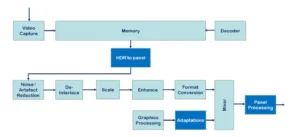Erwin Bellers from Sigma Designs was the last speaker of the day and he came to discuss HDR processing in TVs and how Sigma is incorporating HDR10+ in its new SoC, He started by explaining that Sigma Designs is a fabless chip company with a variety of products. In TVs, Bellers said that it holds a very strong market share among the merchant SoC suppliers (not counting TV brands that make their own SoCs). They were the first merchant TV SoC supplier for Dolby Vision and are now the first to offer HDR10+, along with support for HLG and HDR10, Bellers said.
Bellers then pointed out the “messy” HDR landscape with multiple formats and implementations, metadata types and panel luminance levels. He said that consumers just want a consistently good HDR experience, even with SDR content, so how does a SoC provider manage all this with flexibility and at a competitive price point?
The answer turned out to be a redesigned pipeline for its newest SoCs. Bellers explained that with SDR TVs content first goes to the SoC, then a frame rate conversion module and onto the panel, The SoC does video and audio processing, with the video pipeline consisting of noise/artifact reduction, de-interlacing, scaling, enhancing, and format conversion. At this stage, overlay graphics can be added to the video signal before it is delivered to the panel.
With HDR, much of the processing depends on the capabilities of the panel, so this information is needed at the beginning of the processing pipeline, This is reflected in the pipeline scheme below.
Adaptations of the graphics are needed too so they are not too bright or dim with an HDR image as these are generated with an SDR image in mind. The panel processing block also needs upgrading to deal with global or zone-based dimming backlights and addressing schemes for the panel.
The pipeline for the HDR10+ was then shown as below.
He concluded by noting that Sigma’s SX8 and SX8Lite SoCs will support HLG, HDR10, HDR10+ and Dolby Vision.

